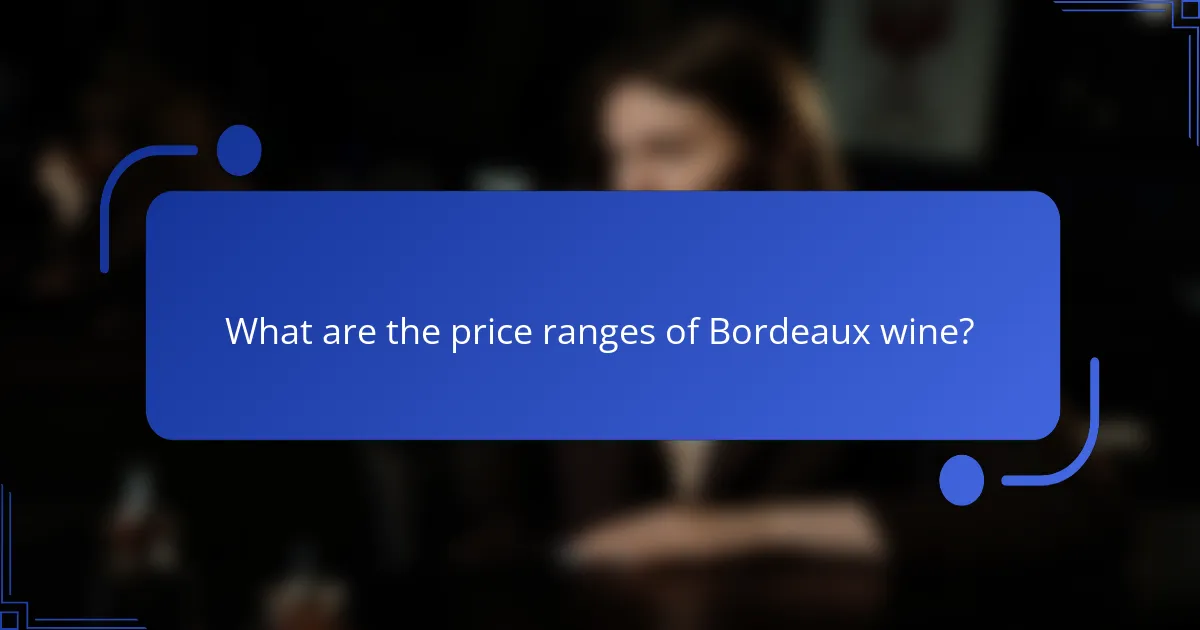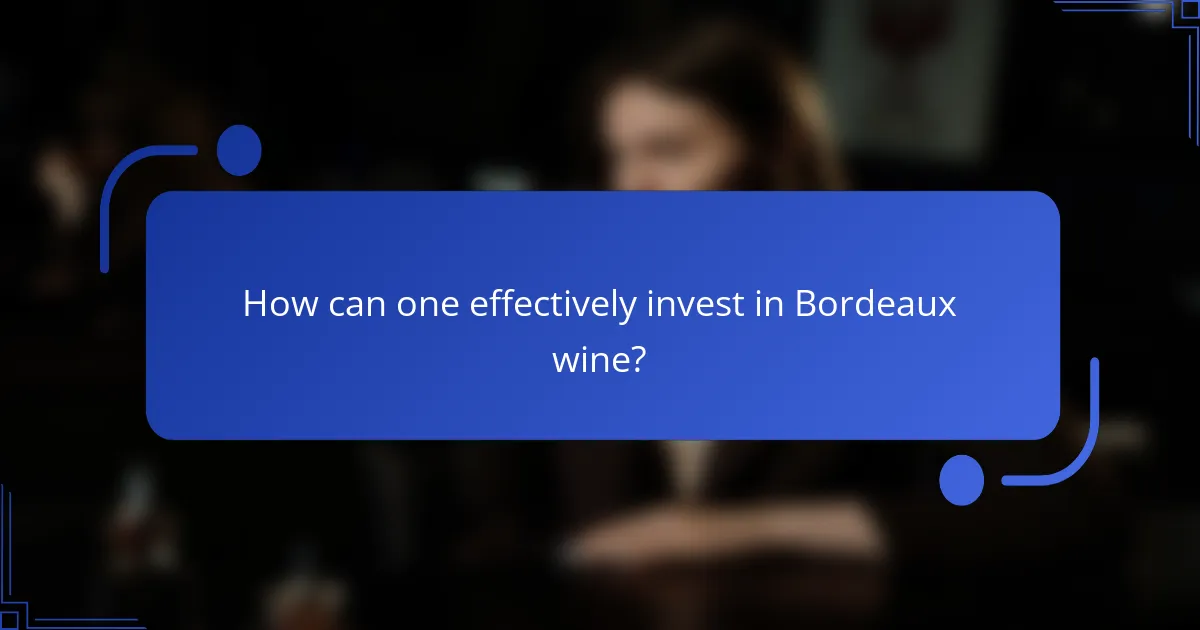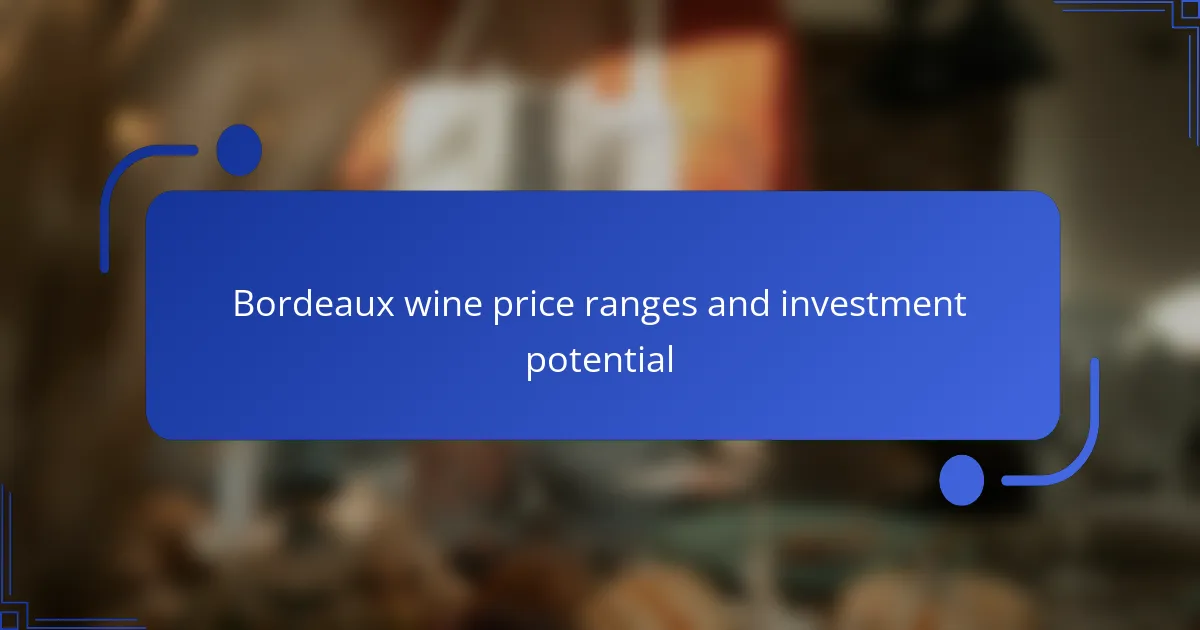
What are the price ranges of Bordeaux wine?
Bordeaux wine prices range from $10 to over $1,000 per bottle. Entry-level Bordeaux wines typically start around $10 to $30. Mid-range Bordeaux wines can cost between $30 and $100. Premium Bordeaux wines often range from $100 to $500. High-end collectible Bordeaux wines can exceed $1,000. The price varies based on factors such as vintage, producer, and region within Bordeaux. Notable wines from prestigious châteaux command higher prices. For example, wines from Château Lafite Rothschild can reach several thousand dollars per bottle.
How do different factors influence Bordeaux wine pricing?
Bordeaux wine pricing is influenced by several factors including vintage quality, terroir, and market demand. Vintage quality significantly affects pricing, as exceptional years yield higher prices due to limited supply. Terroir, which encompasses the geographical and environmental conditions, also plays a crucial role; wines from prestigious regions command premium prices. Market demand fluctuates based on consumer preferences and trends, impacting the overall pricing structure. Additionally, brand reputation and historical significance of the winery can elevate prices. For instance, renowned estates like Château Lafite Rothschild consistently achieve higher market values due to their established prestige. Economic conditions and global wine market trends further influence Bordeaux wine pricing, reflecting broader economic factors.
What role does vintage play in determining price?
Vintage significantly influences the price of Bordeaux wine. The age of the wine often correlates with its quality and scarcity. Older vintages may be more sought after due to their developed flavors and complexity. Specific years are historically known for exceptional weather conditions, resulting in superior grapes. For example, the 1982 Bordeaux vintage is famous for its outstanding quality and high prices. Additionally, market demand for certain vintages can drive prices higher. Collectors and investors often prioritize rare vintages, leading to increased market value. Overall, vintage serves as a key determinant in the pricing structure of Bordeaux wines.
How does the region of production affect Bordeaux wine prices?
The region of production significantly affects Bordeaux wine prices. Bordeaux wines from prestigious regions like Médoc or Saint-Émilion command higher prices. These regions are known for their unique terroir, which influences grape quality. Higher quality grapes lead to better wines, increasing market demand. Additionally, limited production in these areas creates scarcity, driving up prices further. Historical auction results show that top wines from these regions consistently sell for premium prices. For example, wines like Château Lafite Rothschild often exceed $1,000 per bottle due to their esteemed origin. Therefore, the region of production is a key determinant in establishing Bordeaux wine prices.
What are the typical price tiers for Bordeaux wine?
Bordeaux wine typically falls into three main price tiers: entry-level, mid-range, and premium. Entry-level Bordeaux wines generally cost between $10 to $30 per bottle. These wines often include lesser-known châteaux and are suitable for everyday drinking. Mid-range Bordeaux wines typically range from $30 to $100. This tier includes more recognized producers and offers better quality and aging potential. Premium Bordeaux wines, often from prestigious châteaux, can exceed $100 and may reach several thousand dollars per bottle. These wines are sought after by collectors and investors for their rarity and investment potential. The price variations reflect factors such as vineyard reputation, vintage quality, and market demand.
What distinguishes entry-level Bordeaux wines from premium selections?
Entry-level Bordeaux wines are typically characterized by their affordability and accessibility. These wines often come from less prestigious vineyards and may use younger vines. They are produced in larger quantities, making them readily available in the market. In contrast, premium Bordeaux selections are sourced from renowned vineyards with established reputations. These wines are often made from older vines, leading to more concentrated flavors and complexity. Premium selections undergo stricter quality control and may include aging in higher-quality oak barrels. Additionally, premium Bordeaux wines are produced in limited quantities, enhancing their exclusivity and investment potential. The price difference is significant, with entry-level wines generally costing under $20, while premium selections can range from $50 to several hundred dollars. This pricing reflects the quality, rarity, and demand associated with premium Bordeaux wines.
How do prices vary between red, white, and rosé Bordeaux wines?
Red Bordeaux wines typically have higher prices than white and rosé Bordeaux wines. The average price for red Bordeaux can range from $15 to over $300 per bottle, depending on the vineyard and vintage. White Bordeaux wines usually range from $10 to $50, while rosé Bordeaux wines are often priced between $10 and $25. The demand for red Bordeaux wines contributes to their higher prices. Additionally, renowned producers and aging potential further increase red Bordeaux prices. In contrast, white and rosé wines generally cater to a broader audience, resulting in lower price points.

What is the investment potential of Bordeaux wine?
The investment potential of Bordeaux wine is significant due to its historical appreciation in value. Bordeaux wines have shown consistent demand in the global market. Notably, the Liv-ex Fine Wine 100 index indicates a 150% increase in value over the past decade. This trend is supported by limited supply and growing interest from investors. Specific vintages, such as those from 2000, 2005, and 2010, are particularly sought after. Additionally, Bordeaux wines are often considered a hedge against inflation. The market for fine wine continues to expand, attracting both seasoned investors and newcomers.
Why consider Bordeaux wine as an investment option?
Bordeaux wine is considered a strong investment option due to its historical appreciation in value. The Bordeaux wine market has shown consistent growth over decades. Fine wines, particularly from prestigious châteaux, often appreciate significantly over time. For instance, the Liv-ex Fine Wine 100 index, which tracks the price performance of the top 100 wines, has increased by over 200% since its inception in 2001. Additionally, Bordeaux wines are globally recognized and sought after, ensuring high demand. The limited production of certain vintages also contributes to their scarcity and value. Collecting Bordeaux wine can provide both enjoyment and financial returns.
What historical performance trends exist for Bordeaux wine investments?
Bordeaux wine investments have shown a generally positive historical performance trend. Over the last two decades, the Bordeaux Fine Wine Index has appreciated significantly, with an average annual return exceeding 10%. Notably, the 2009 and 2010 vintages experienced substantial price increases, often doubling in value within a few years. Demand from emerging markets, particularly in Asia, has driven prices higher, especially for prestigious labels. Additionally, the scarcity of top vintages contributes to price stability and growth. Historical auction results indicate that rare Bordeaux wines consistently fetch high prices, reinforcing their investment potential.
How does Bordeaux wine compare to other investment assets?
Bordeaux wine is a unique investment asset that often appreciates over time. Historical data shows that fine wines, particularly Bordeaux, have outperformed traditional investments like stocks and bonds. According to the Liv-ex Fine Wine 100 index, Bordeaux wines increased in value by over 200% from 2005 to 2020. This growth is attributed to limited supply, increasing global demand, and the wine’s historical prestige. Additionally, Bordeaux wine can provide diversification in an investment portfolio. Unlike stocks, wine is a tangible asset that can retain value even during market downturns. Furthermore, wine investments often have lower volatility compared to equities. Therefore, Bordeaux wine stands out as a reliable and profitable investment option compared to other assets.
What are the risks associated with investing in Bordeaux wine?
Investing in Bordeaux wine carries several risks. Market volatility can lead to significant price fluctuations. Economic downturns can reduce demand for luxury wines. Storage conditions can affect wine quality, impacting value. Fraud and counterfeit wines pose a risk to investors. Lack of liquidity may hinder the ability to sell quickly. Changes in consumer preferences can affect market trends. Regulatory changes can impact import/export dynamics. Historical data shows that prices can decline, affecting investment returns.
What market fluctuations should investors be aware of?
Investors should be aware of price volatility in the Bordeaux wine market. This fluctuation can result from changes in supply and demand. Economic factors, such as inflation and currency exchange rates, also impact prices. Additionally, vintage quality significantly influences market values. For example, the 2010 Bordeaux vintage saw a price increase of up to 30% within a year. Market trends can shift due to global events, affecting investor sentiment. For instance, trade tariffs can disrupt imports and exports, influencing prices. Understanding these fluctuations is crucial for making informed investment decisions in Bordeaux wines.
How does storage impact the value of Bordeaux wine investments?
Storage significantly impacts the value of Bordeaux wine investments. Proper storage conditions preserve wine quality and enhance its market value. Bordeaux wines require stable temperatures, ideally between 50-55°F. Humidity levels must be maintained at around 70% to prevent cork damage. Poor storage can lead to spoilage, affecting taste and aroma. Wines stored in optimal conditions often appreciate in value over time. Conversely, improperly stored wines may depreciate or become unsellable. Historical data shows that well-stored Bordeaux wines consistently fetch higher auction prices. Thus, storage is crucial for maximizing investment returns in Bordeaux wines.

How can one effectively invest in Bordeaux wine?
To effectively invest in Bordeaux wine, one should focus on quality and provenance. Investing in wines from reputable châteaux is crucial. Notable examples include Château Lafite Rothschild and Château Margaux. Researching vintages is also important, as some years yield better quality wines. The Bordeaux Wine Official Classification of 1855 can guide selections. Additionally, proper storage conditions enhance wine value over time. Investing in wine funds or auctions can provide broader access to premium bottles. According to Liv-ex, Bordeaux wines have historically outperformed the stock market in the long term.
What strategies should investors employ when purchasing Bordeaux wine?
Investors should focus on provenance, vintage quality, and market trends when purchasing Bordeaux wine. Provenance ensures the wine’s history and authenticity, which can significantly affect its value. High-quality vintages, such as those from 2000, 2005, and 2010, often appreciate more over time. Investors should also analyze market trends to identify which wines are gaining popularity. Engaging with reputable wine merchants and attending auctions can provide access to exclusive bottles. Diversifying the portfolio by including wines from different regions and vintages can mitigate risks. Keeping track of wine ratings from critics like Robert Parker can guide purchasing decisions. Lastly, proper storage conditions are essential to maintain wine quality and investment value.
How can one identify high-potential Bordeaux wines for investment?
To identify high-potential Bordeaux wines for investment, focus on specific characteristics. Look for wines from renowned regions like Médoc, Pomerol, and Saint-Émilion. Assess the wine’s vintage; exceptional years, such as 2005, 2009, and 2010, often yield higher returns. Evaluate the producer’s reputation; established châteaux like Château Lafite Rothschild and Château Margaux typically appreciate in value. Check critic scores and reviews; wines rated above 90 points by experts often indicate investment potential. Analyze market trends; wines with increasing demand and limited supply tend to perform better. Historical price performance can also guide decisions; consistent appreciation over time is a positive sign.
What resources are available for tracking Bordeaux wine market trends?
Resources for tracking Bordeaux wine market trends include wine market reports, online auction platforms, and industry publications. Market reports, such as those from Liv-ex, provide data on price movements and trends. Online auction platforms like Sotheby’s and Christie’s offer real-time pricing and sales data. Industry publications, including Wine Spectator and Decanter, feature articles on market analysis and expert opinions. Additionally, Bordeaux wine brokers can provide insights and advice on investment potential. These resources collectively help investors and enthusiasts stay informed about the Bordeaux wine market.
What tips can enhance Bordeaux wine investment success?
Investing in Bordeaux wine can be enhanced by focusing on quality, provenance, and market trends. Selecting wines from reputable producers is crucial. Wines with a strong track record of appreciation tend to perform better. Understanding the vintage variations helps in making informed decisions. Monitoring market demand for specific labels can guide purchases. Diversifying investments across different Bordeaux regions mitigates risk. Proper storage conditions maintain wine quality and value. Engaging with wine experts or investment advisors can provide valuable insights.
How important is diversification within a Bordeaux wine portfolio?
Diversification within a Bordeaux wine portfolio is crucial for managing risk and maximizing returns. A diverse selection of wines from various producers, vintages, and regions can help mitigate the impact of market fluctuations. Bordeaux wines can vary significantly in price and quality, making it essential to include different tiers in a portfolio. Historical data shows that portfolios with diversified holdings often outperform those concentrated in a single category. For instance, during economic downturns, lower-tier wines may hold value better than high-end wines. Additionally, a well-rounded portfolio can appeal to a broader range of buyers, enhancing liquidity. Therefore, diversification is a strategic approach to enhance both stability and potential growth in Bordeaux wine investments.
What are the best practices for selling Bordeaux wine investments?
The best practices for selling Bordeaux wine investments include thorough research and proper valuation. Understand the current market trends and price ranges for Bordeaux wines. Ensure that you have accurate information on the wine’s provenance and quality. Utilize reputable wine auction houses or platforms for selling. Engage with knowledgeable wine brokers who can facilitate the sale. Maintain detailed records of the wine’s storage and condition to enhance buyer confidence. Timing the market can also influence the sale price positively. Bordeaux wines have shown appreciation, with some vintages increasing in value by over 200% in a decade.
Bordeaux wine is a highly valued entity known for its diverse price ranges and significant investment potential. Prices for Bordeaux wines typically range from $10 to over $1,000 per bottle, influenced by factors such as vintage quality, region of production, and market demand. The article explores price tiers, distinguishing characteristics between entry-level and premium selections, the impact of vintage and terroir on pricing, and the historical performance trends of Bordeaux wine as an investment. Additionally, it provides insights into strategies for effective investment, risks associated with wine investing, and best practices for selling Bordeaux wine investments.
